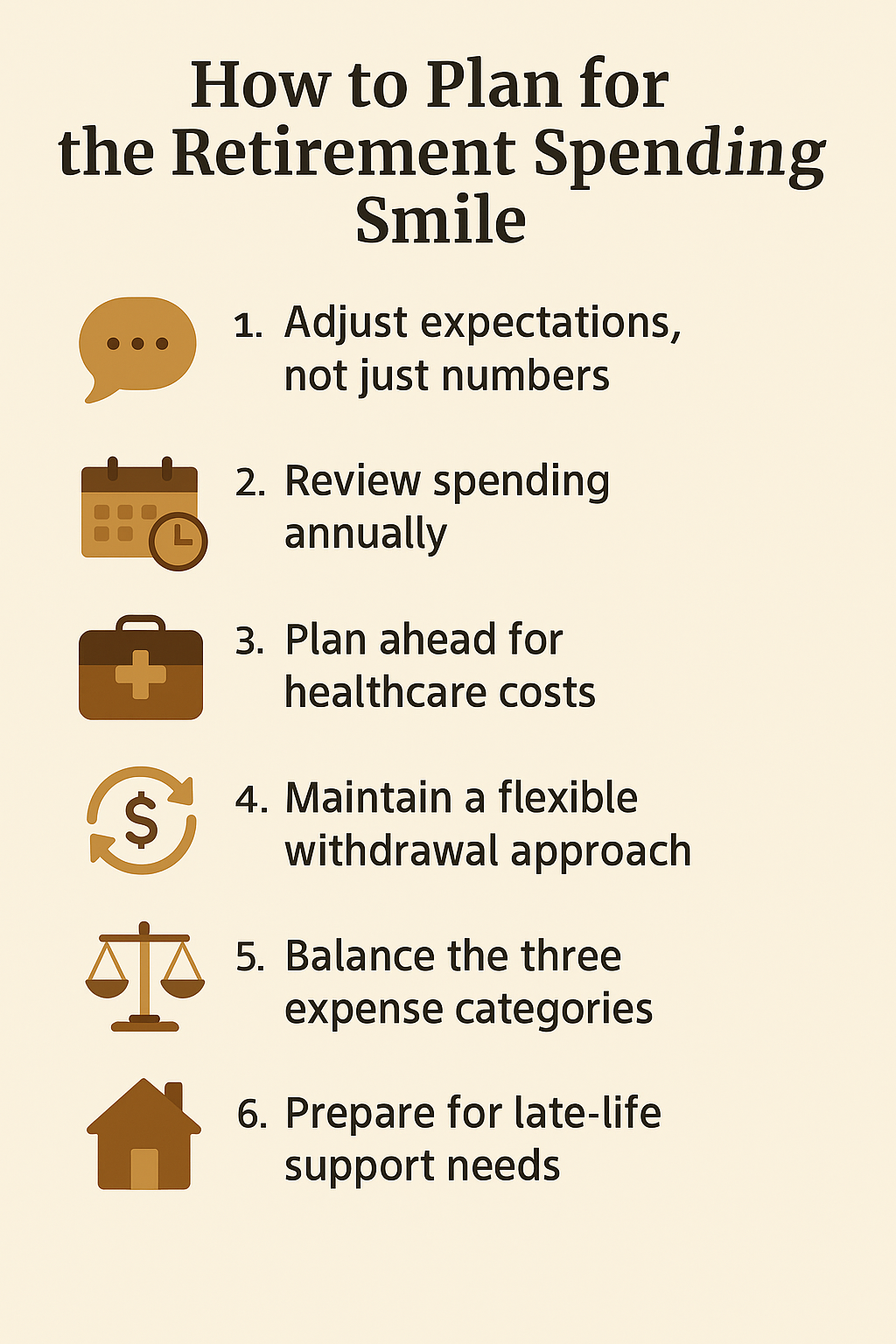The Retirement Spending Smile Explained

The Retirement Spending Smile: Why You Might Spend Less (Then More)
Most people assume retirement spending is a straight line — steady, predictable, and consistent from year to year. But decades of research tell a different story. In reality, many retirees follow what economists call the “retirement spending smile,” a pattern where expenses start higher early in retirement, decline in the middle years, and rise again later in life.
Understanding this pattern can help you plan more confidently, avoid surprises, and align your financial decisions with how retirement actually unfolds — not just how you imagine it.
This guide breaks down what the spending smile means, why it happens, and how you can prepare for each stage, no matter where you live or what your cost of living looks like.
What Is the Retirement Spending Smile?
The retirement spending smile describes how expenses typically change across three stages of retirement:
- Higher spending in early retirement
- Lower spending in mid-retirement
- Rising spending in late retirement
The curve resembles a smile — high on both ends and lower in the middle.
This pattern appears consistently among retirees across the U.S. regardless of income level, lifestyle, or state-specific costs. While your personal spending will vary, the general trend is common and well-documented.
Stage 1: Early Retirement (Higher Spending)
This stage often includes ages 60–70, though timing varies.
You’re newly retired. You feel energetic. You finally have free time — and you want to enjoy it.
Many retirees spend more early on because they are:
- Traveling more
- Eating out frequently
- Updating their home
- Pursuing hobbies
- Helping family
- Making long-postponed purchases
These are positive, intentional choices — not mistakes. But understanding this natural spending increase helps you plan for it without guilt or surprise.
Q: Is it normal to spend more when you first retire?
A: Yes. Most retirees do. Lifestyle spending often peaks early before settling into a steadier rhythm later.
Stage 2: Mid-Retirement (Lower Spending)
This stage often reflects the 70s and early 80s.
During this period, many retirees:
- Travel less
- Own fewer cars
- Spend more time at home
- Have fewer large purchases
- Enjoy quieter routines
Lifestyle slows down naturally, and spending slows with it.
Essential costs remain — housing, food, utilities, healthcare — but discretionary expenses often decline. This is the “dip” in the spending smile.
This is also a powerful time to review income withdrawals, budgets, and long-term planning to prepare for the next phase.
Stage 3: Late Retirement (Higher Spending Again)
Eventually, spending rises again — this time for different reasons.
Common later-life expenses include:
- Increased healthcare needs
- Long-term care or support
- Home modifications
- Help with daily tasks
- Medications
- Transportation alternatives
How much later-life spending rises varies based on:
- Health
- Local healthcare costs
- Insurance availability
- Whether you age at home or in a facility
- Family support
These expenses can be unpredictable, but planning ahead is the key to staying financially steady.
Q: Does every retiree spend more later in life?
A: Not everyone. But many people experience increased medical or support costs as they age, which is why planning is so important.
Why the Spending Smile Matters
Understanding this pattern helps retirees:
- Plan realistic budgets
- Avoid underspending or overspending
- Prepare for healthcare costs
- Set sustainable withdrawal rates
- Reduce anxiety about long-term expenses
- Make decisions from a place of clarity, not fear
The smile helps you see retirement as a dynamic experience — not a fixed budget.
How to Plan for the Retirement Spending Smile
1. Adjust Expectations, Not Just Numbers
A successful retirement plan should fit how you actually live — not how a spreadsheet predicts you should live.
This means acknowledging that your spending will evolve over time.
2. Review Spending Annually
Costs can vary dramatically depending on your state or city — especially housing, insurance, and healthcare. An annual check-in keeps your plan aligned with your real-life needs.
Q: How often should retirees revisit their budget?
A: Many retirees review it once a year. This catches shifts early and prevents unpleasant surprises.
3. Plan Ahead for Healthcare Costs
Later-life expenses are often healthcare-related. You don’t need to predict everything — you just need to anticipate that costs may rise.
Ways to prepare include:
- Keeping an emergency fund
- Reviewing insurance coverage annually
- Understanding local healthcare costs
- Budgeting for future care needs
4. Maintain a Flexible Withdrawal Approach
Rigid withdrawal strategies don’t match the natural ebb and flow of spending.
Flexibility helps you to:
- Withdraw more when needed
- Withdraw less during quieter years
- Preserve savings for later retirement
- Reduce stress when markets fluctuate
5. Balance the Three Expense Categories
Just like earlier articles in this series, break spending into:
- Essentials — the must-haves
- Lifestyle — the nice-to-haves
- Future planning — potential future costs
The middle category changes significantly across the spending smile.
6. Prepare for Late-Life Support Needs
Some retirees choose to:
- Downsize
- Move closer to family
- Modify their home
- Research care options early
Planning ahead reduces emotional and financial stress later in life.

Q&A: Quick Answers About Retirement Spending
Q: Will inflation affect the spending smile?
A: Yes. Rising costs can shift the curve upward, especially for essentials like food, housing, and healthcare.
Q: Does location impact spending patterns?
A: Absolutely. Healthcare, taxes, insurance, and housing vary from state to state.
Q: What if my spending doesn’t match the smile?
A: That’s okay. The smile is a general pattern, not a rule. Your personal lifestyle and needs will shape your own curve.
🐾 Tootsie’s Takeaway
A happy retirement is like a comfy nap — sometimes active, sometimes quiet, and eventually needing a little extra support. Plan ahead, and enjoy every stage.
Written by Brent Meyer, founder of SafeMoney.com. With more than 20 years of experience helping families navigate retirement and legacy planning, Brent is committed to making financial education simple, clear, and trustworthy.
Disclaimer: SafeMoney.com provides financial education only. For guidance on your specific situation, consult a licensed professional.








